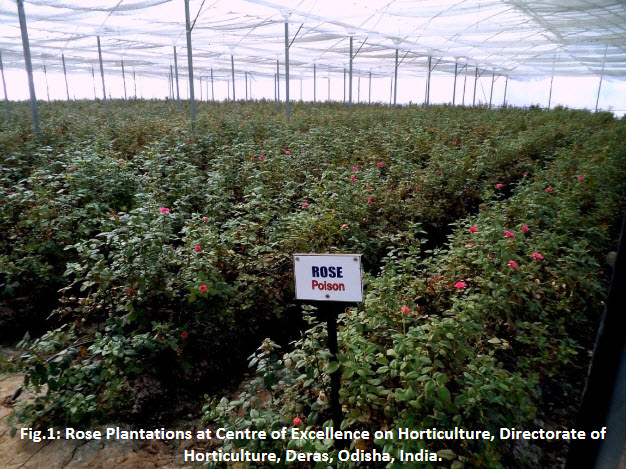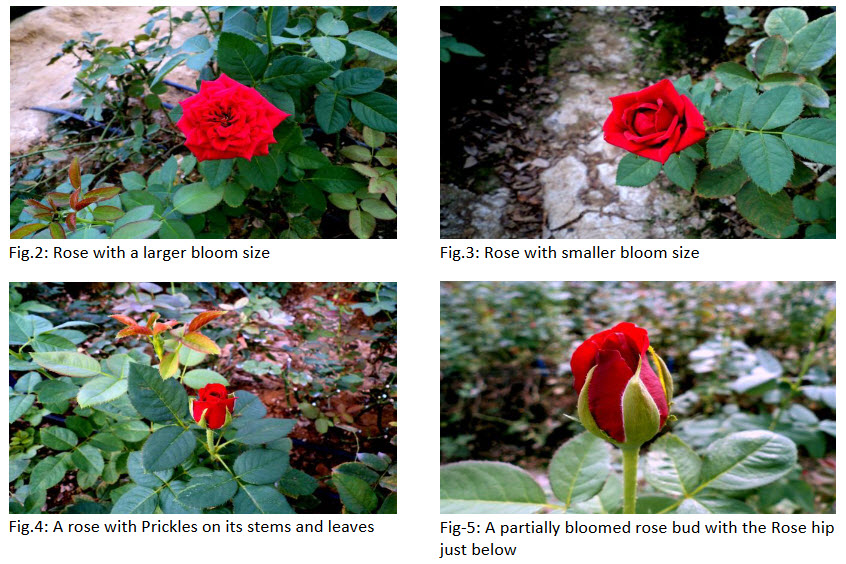{ DOWNLOAD AS PDF }
ABOUT AUTHORS:
Sonali Nanda, Pratyush Kumar Das*
Centre of Biotechnology, Siksha O Anusandhan University,
Bhubaneswar, Odisha, India
*das.pratyushkumar@yahoo.co.in
ABSTRACT
A rose is a woody perennial plant belonging to the genus Rosa in the family Rosaceae. Known for its sweet smell and beauty, generally is used as a decorative in household and public gardens. Besides being used as a decorative, very few know its use as a medicinal herb. The petals, stems, leaves and roots of a rose plant contain various secondary metabolites and nutrients in the form of vitamins and minerals. Extracts from different parts of rose plant have also been reported to show substantial anti-bacterial and anti-fungal activity. The parts of the plant especially the petals have high antioxidant property that helps in curing many health ailments. In this review the various vital constituents and medicinal properties of different parts of the plant have been highlighted. The information were collected online from various research papers and websites using search engines and assembled in a sequential manner to provide a complete knowledge guide for the readers.
INTRODUCTION
A rose is a woody perennial plant of the genus Rosa within the family Rosaceae. The leaves of the plant are alternate to each other on the stem. Best known for its ornamental values, most of the rose plants are deciduous except a few from the south east asia that are evergreen. The aggregate fruit of the rose is a pot-like structure containing the seeds in it called the rose hip. Each hip consists of an outer fleshy layer called hypanthium which contains few to large number of seeds embedded in a matrix of fine but stiff hairs. The sharp objects along the stem of a rose plant are outgrowths of the epidermis called as prickles.

Fig.1: Rose Plantations at Centre of Excellence on Horticulture, Directorate of Horticulture, Deras, Odisha, India.
Classification of Rose:
1. Botanical Classification of Rose: The Genus Rosa is subdivide into 4 subgenera –
a. Hulthemia-Includes R.persicaand R.berberifolia. These are the only two roses that have compound leaves.
b. Hesperrhodos-Includes R.minutifoliaand R.stellata.
c. Platyrhodon-Includes R.roxburghii.
d. Rosa- This subgenera includes 11 sub sections – R.banksianae, R.bracteatae, R.caninae, R.carolinae, R.chinensis, R.gallicanae, R.gymnocarpae, R.laevigatae, R.pimpinellifoliae, R.rosaand R.synstylae[1].
2. Classification of Rose based on size: In general, depending on their size, there are nine different classes or groups of roses- Micro-miniatures, Miniatures, Mini-Floras, Floribundas, Grandifloras, Hybrid Teas, Climbers, Shrubs and Old Garden Roses[2].
a. Micro-miniature Roses: They are the smallest of roses and can only grow to a height of 12-14 inches and are just the size of a dime when completely bloomed. Example of such type of rose is “Cindrella”.
b. Miniature Roses: They are little bigger than micro-miniature rose plants, can grow to a height of 2-3 feet and its blooms are 1-2 inches across. Example of a miniature rose is “Sun Sprinkle”.
c. Mini-Flora Rose: Got its name because of its bigger size than miniature but smaller than Floribunda. Plants can reach upto a height of 3-4 feet and blooms can be 3-4 inches across.
d. Flloribunda Rose: Typically grows to a height of 4-5 feet. Consists of huge clusters of flowers such that each cluster can make a bouquet.
e. Grandiflora Rose: The plant can reach up to 6 feet in height. Has long stems with 3-4 blooms per stems. Have bigger flower than floribunda but are fewer in number. “Dream Come True” and “Sweetness” are the examples of Grandiflora.
f. Hybrid Tea Rose: Plants can reach to a height beyond 6 feet and blooms can be 6 inches across. They consist of a long stem with one huge flower at the end. Example of hybrid rose is “Red Intuition”.
g. Climbers: They generally grow on a support or wall of a building and can reach 12-15 feet. Some of them even cover an area of 8,000 sq. feet. “Lady Banks” is a climber.
h. Shrubs: This ranges in size from ground covers to shrubs. Can have a wide range of bloom size. Example- “Double Pink Knockout”.
i. Old Garden Roses:Sometimes called “antique roses”, can have a wide range of growth habit and bloom size and are highly fragrant. They usually bloom only in the spring or early summer. “Paul Neyron” is an example.

Medicinal Values of Rose Plant:
The medicinal parts of the plants are the flowers, petals, rose hips, root, root bark and essential oil. Essential oil, Vitamins and Minerals which include Vitamin A, B, E and K and potassium and iron form the key medicinal components. The extract of rose plant especially act as an antidepressant, antibacterial, antifungal, antiseptic, anti-inflammatory, digestive stimulant, kidney tonic and menstrual regulator. Mainly from the family Rosaceae certain flowers like R.canina, R.arkansana, R.laevigata, R.gallica, R.damascena, R.rugosaand R.multiforaexhibit wide range of medicinal effects.
Traditional Uses of Rose:
The hips of wild rose have very high concentration of Vitamin C, almost thrice that of the citrus fruits have. The Chinese use the flowers to prepare a drink which acts as an energy stimulant, blood tonic and also works in case of digestive irregularities. Petals of R.damascena are steam distilled to produce true Bulgarian rose oil used in 96 percent of all women’s perfumes. Medicinally it is used to alleviate depression and anxiety[3].
Rose Hips – Uses, Medicinal Values and Side effects:
Rose hips also known as seed pot is the round portion just below the petals of rose flower which contains the seeds of a rose plant. Fresh rose hips contain high concentration of Vitamin C and can be used for treatment of cold and flu and Vitamin C deficiency. Moreover, they are also used for stomach disorders like stomach acid deficiency, Gall stones and Gall bladder ailments, Kidney disorders, increasing immune function during exhaustion etc. In food and manufacturing industry they are also used in tea, jam etc. as a natural source of Vitamin C. But despite of all these uses they too have many side effects. Due to high concentration of Vitamin C, it may lead to many side effects such as increasing the risk for kidney stones, increasing acidity of blood, delaying blood clotting time and increased iron absorption that may affect patients with iron related disorders and many more[4].
Antibacterial (Antimicrobial) and Antifungal Activity of Extracts from Rose
Antimicrobials or anti-bacterial are generally compounds that kill or slows down the growth of bacteria [5]. Extracts of rose petals have been reported to show anti-bacterial activity against many pathogenic bacteria. The extracts of petals possess anthocyanins that have high antioxidant property as well as anti-inflammatory activity[6]. Anthocyanins are basically polyphenols belonging to the family of compounds known as flavonoids. They are largest group of water soluble pigments present in nature and responsible for red, blue, purple and orange coloration of many fruits, flowers and vegetables[7]. They are distinguished from other flavonoids by their capacity to form flavyliumcations[8]. Rose petal water has also been used as an eye wash and mouth wash. Besides containing anthocyanins the petals of rose are also reported to possess carotenoids, proanthocyanidins, essential oils, Tellimagrandin I, plant acids and Rugosin B. The alcohol Geraniol is the chief constituent of the liquid portion of rose oil, which upon oxidation yields Citral- an aldehyde. The oil of rose also contains 1-citronellol [6]. Extract from Rosa canina L. petals have been reported to increase effectiveness of many antibiotics against methicillin- resistant Staphylococcus aureus[9]. Recent research shows that extracts from rose petals show good antimicrobial activity against cultures of E.coli, S.pneumoniae and P.aeruginosa. As per the study, the alcoholic extract showed the best activity against different pathogenic bacteria followed by the aqueous extract and then the petroleum ether extract [10]. Antibacterial activity of different parts of rose plant has also been carried out where in comparison was made between methanolic and ethanolic extracts of petals, stems and roots of red and yellow rose plant. The report highlighted the antibacterial effect of red rose petal as compared to other extracts. The extract was reported to be highly effective against cultures of E.coli, S.aureus and P.aeruginosa[11]. The comparision of ethanolic extracts of petals and leaves of red rose and orange rose reported by Pandey et al. 2012, showed maximum activity against P.aeruginosa[12]. A recent study reported moderate to broad spectrum antimicrobial activity of essential oil and different extracts of R. damascena petals against varied gram positive and gram negative bacteria, acid fast bacteria and fungi. Antifungal activity against Penicilliumnotatum, A.niger and Candida albicans and antibacterial activity mainly against gram positive S.aureus, B.subtilis, S.pyogenes and gram negative Acinetobacterbaumannii is notable [13].
Cytotoxic and Anti-oxidative Property of Rose Extracts
Aqueous extract of white rose (Rosa damascene) have been studied for their anti-oxidative and cytotoxic properties. The extract has been reported to display excellent cytotoxic action towards the human tumor cell line. At lower doses the extract was reported to show decrease in blood parameters like fasting glucose, creatinine, blood urea nitrogen and uric acid. The work also reported reduced level of alkaline phosphatase, glutamine pyruvate transaminase, glutamine oxaloacetate transaminase and lipid peroxide level in rats receiving oral administration of acetone extract at 50 mg/kg body weight [14].
CONCLUSION
The whole review has aimed to create the importance of rose as not only as an ornamental plant but a plant with high medicinal efficacy. It has highlighted its importance as an antibacterial, antifungal and as well as an antioxidant along with proving it to be a rich source for important vitamins and minerals. There are many more essential compounds in the plant that are yet to be known and used. Hence, it creates further research opportunities in this field. Work can be done to produce essential medicines, drugs and other products from the plant rather than just using it as an ornamental plant for decoration purposes.
REFERENCES
1. http://en.wikipedia.org/wiki/Rose
2. Classes and Shapes of Roses- online pdf from American Rose Society.
3. cloverleaffarmherbs.com/rose/
4. webmd.com/vitamins-supplements/ingredientmono-839-rose%20hip.aspx?activeingredientid=839&activeingredientname=rose%20hip
5. PK Das, S Das, D Sahoo, J Dalei, VM Rao, S Nayak, S Palo; Comparative Evaluation ofPurification Methods for Production of Polypeptide Antibiotics – “Polymyxin B” and “Cerexin A” from BacillusSpecies; PharmaTutor; 2014; 2(8); 188-200.
6. Akhmadieva A.K., Zaichkina S.I., Ruzieva R.K. and Ganassi E.E; The protective action of a natural preparation of anthocyanin (Pelargonidin-3,5-diglucoside); Radio biologica; 1993; 33(3); 433-435.
7. Harborne J.B; Phenolic compounds in phytochemical methods –a guide to modern techniques of plant analysis; Chapman & Hall; New York, 1998, Edn 3; 66-74.
8. Miguel M.G; Anthocyanins: Antioxidant and/or anti-inflammatoryactivities; Journal of Applied Pharmaceutical Science; 2011; 01(06); 07-15.
9. Rossnagel K., Willich S.N; Value of complementary medicine exemplified by rose hips; Gesundheitsween; 2001; 63(6); 412-416.
10. Hirulkar N.B., Agrawal M; Antimicrobial activity of rose petals extract against some pathogenic bacteria; International Journal of Pharmaceutical and Biological Archives; 2010; 1(5); 478-484.
11. Khan J.A., Tiwari S; A study on antibacterial properties of Rosa indica against various pathogens; Asian Journal of Plant Science and Research; 2011; 1(1); 22-30.
12. Pandey A., Kumar K., Kumari D.; A comparative analysis of antibacterial properties of different varieties of Rosa indica leaves and petals against various pathogens; 2012; 3(12); 39-47.
13. Sohayeb M., HameedES.S.A.,Bazaid S.A., Maghrabi I; Antibacterial and antifungal activity of Rosa damascene MILL. Essential oil, Different extracts of rose petals; Global Journal of Pharmacology; 2014; 8(1); 01-07. (DOI: 10.5829/idosi.gjp.2014.8.1.81275).
14. Kashani A.D., Rasooli I., Rezaee M.B., Owlia P; Antioxidative properties and toxicity of white rose extract; Iranian Journal of Toxicology; 2011; 5(1&2); 415-425.
REFERENCE ID: PHARMATUTOR-ART-2363
|
PharmaTutor (Print-ISSN: 2394 - 6679; e-ISSN: 2347 - 7881) Volume 3, Issue 10 Received On: 20/05/2015; Accepted On: 01/06/2015; Published On: 01/10/2015How to cite this article: S Nanda, PK Das; Medicinal Efficacy of Rose Plant: A Mini Review; PharmaTutor; 2015; 3(10); 23-26 |
NOW YOU CAN ALSO PUBLISH YOUR ARTICLE ONLINE.
SUBMIT YOUR ARTICLE/PROJECT AT editor-in-chief@pharmatutor.org
Subscribe to Pharmatutor Alerts by Email
FIND OUT MORE ARTICLES AT OUR DATABASE











.png)

